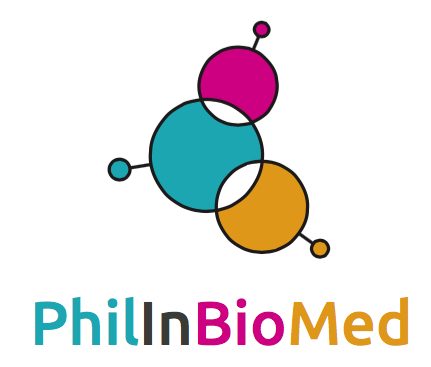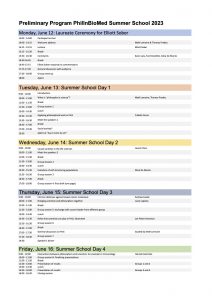Introductions
The summer school will start with a round of introductions, where all participants will have 2 minutes each to briefly introduce themselves . Please prepare one slide summarizing your background, interests, work, and anything else you would like to share and send it to us (fridolin.gross [at] u-bordeaux.fr) no later than Sunday, June 11.
Group Projects
An important part of the Summer School is a group activity in which you will go through the steps of a philosophy in science project under the guidance of a scientist and a philosopher. To make sure that the group work is interesting and relevant, we have asked our guest speakers to propose topics in line with their research interests. Below you will find materials to help you prepare for the project. We have assigned you to one of the groups based on your application profile. Please check which group you have been assigned to and read the corresponding description.
The readings for all groups can be found here. The password to access the folder has been sent to all participants by e-mail.
Group 1: Fitness and levels of biological organization
Course leaders
Silvia De Monte, Fridolin Gross
Group members
Clifford Clemotte, Mitchell Distin, Yesim Erol, Nicola Fresco, Linda Grohmann, Vanessa Lovato
Description
How does fitness “currency” (i.e. the way reproductive success is quantified) affect the notion of conflict within and between levels of biological organization?
Preparation
In order to prepare the group work, we invite you to read the following texts in advance. Please make a note of any comments and ideas (hypotheses, criticisms, questions, etc.) you have while reading, so that they can serve as starting material for group discussions during the Summer School.
Here are some initial questions to guide your preparation:
- What ‘conflicts’ are relevant for evolution occurring on multiple levels of organization (e.g. cellular and multicellular)?
- How are they grounded in the ecology of the populations at different levels (e.g. cells and organisms)?
- How can one measure those conflicts?
- Do those measures allow to predict evolutionary outcomes? Under what conditions?
Readings
- Bourrat, Pierrick. “Levels of Selection Are Artefacts of Different Fitness Temporal Measures: Fitness and Levels of Selection.” Ratio 28, no. 1 (March 2015): 40–50. https://doi.org/10.1111/rati.12053.
- De Monte, Silvia, and Paul B. Rainey. “Nascent Multicellular Life and the Emergence of Individuality.” Journal of Biosciences 39, no. 2 (April 1, 2014): 237–48. https://doi.org/10.1007/s12038-014-9420-5.
- Doebeli, Michael, Yaroslav Ispolatov, and Burt Simon. “Towards a Mechanistic Foundation of Evolutionary Theory.” Edited by Wenying Shou. ELife 6 (February 15, 2017): e23804. https://doi.org/10.7554/eLife.23804.
- Doulcier, Guilhem, Amaury Lambert, Silvia De Monte, and Paul B Rainey. “Eco-Evolutionary Dynamics of Nested Darwinian Populations and the Emergence of Community-Level Heredity.” Edited by Wenying Shou, Patricia J Wittkopp, Wenying Shou, Sara Mitri, and Alvaro Sanchez. ELife 9 (July 7, 2020): e53433. https://doi.org/10.7554/eLife.53433.
Group 2: Stem cells in development and cancer
Course leaders
Andrew Ewald, Lucie Laplane, Thomas Pradeu
Group members
Yanis Asloudj, Illir Isufi, Anna Maas, Benjamin Spada, Jeanne Trouvé
Description
Background: Cells in the body do not have the same potential to multiply or differentiate. At the extremes, eggs and sperm are capable of generating the entire organism, while vertebrate red blood lack even nuclei. This process of specialization begins very early, just a few cell divisions into embryo formation. Understanding how proliferative and differential potential is allocated across cell types and contexts is of fundamental interest, is critical to the development of regenerative medicine, and could inform the development of effective anti-cancer therapeutics.
The major term used to discuss how cells differ is these properties is ‘stem cell’. The modern conception of the stem cell is heavily influenced by concepts that emerged from the study of the hematopoietic (blood cell producing) system. The key innovation there was the technique of irradiation and bone marrow transplantation. The irradiation will eliminate the capacity to produce new blood cells and leads to death within weeks as existing blood cells turn over. Transplanted bone marrow cells will engraft and produce new blood cells and will rescue the mouse, if they have high enough proliferative and differentiation potential. Researchers were therefore able to define molecularly-specific subsets of bone marrow cells and transplant them to test for the extent of rescue. Transplantation of complete bone marrow resulted in complete rescue. Terminally differentiated cell types were identified because they could not give rise to other cell lineages following transplantation, therefore failing to rescue. Committed multilineage cells were defined because they could give rise to multiple but not all cell types of the blood. Short term stem cells were defined because they could give rise to all cell types of the blood but they could not renew themselves, leading to eventual bone marrow collapse. The long term hematopoietic stem cell (HSC) was identified for its ability to both generate all lineages of the blood system and ‘self-renew’ indefinitely. This framework, though developed in a specific organ context, became the paradigm for how to think about stem cells in general. Key assumption of the HSC model is that long term regenerative potential is highly restricted to a small minority of the population and that cells can only become more, never less, differentiated.
It has always been unclear which aspects of the HSC model are relevant for normal epithelial organs, which are subject to very different developmental constraints than the blood system. Epithelial organs are responsible for establishing barriers between the organism and the environment as well as compartments within and between organs. If these barriers fail even briefly, the organism can die. It might be adaptive for epithelial cells to retain significant, perhaps contextual, ability to dedifferentiate in order to repair damage and restore tissue homeostasis. On the other hand, immune cells are capable of traveling to all parts of the body and, in principle, of dividing when they arrive to expand into substantial populations. It might be adaptive for blood cells to default towards cell death without the possibility of dedifferentiation.
Preparation
Read the following three reviews to get a background in the concept of stem cells. Then pick an organ and identify several papers that provide evidence for the existence and properties of stem cells in its normal and cancer context. Identify one paper that provides an alternative point of view and assess its logical consistency. Is the definition of stem cell sound in the organ you selected? In its corresponding cancers? What doesn’t fit?
Readings
- Rawlins, Emma L., and Brigid L. M. Hogan. “Epithelial Stem Cells of the Lung: Privileged Few or Opportunities for Many?” Development (Cambridge, England) 133, no. 13 (July 2006): 2455–65. https://doi.org/10.1242/dev.02407.
- Reya, T., S. J. Morrison, M. F. Clarke, and I. L. Weissman. “Stem Cells, Cancer, and Cancer Stem Cells.” Nature 414, no. 6859 (November 1, 2001): 105–11. https://doi.org/10.1038/35102167.
- Vermeulen, L., M. R. Sprick, K. Kemper, G. Stassi, and J. P. Medema. “Cancer Stem Cells–Old Concepts, New Insights.” Cell Death and Differentiation 15, no. 6 (June 2008): 947–58. https://doi.org/10.1038/cdd.2008.20.
Group 3: What is a pathogen?
Course leaders
Hannah Kaminski, Maël Lemoine
Group members
Claudio Davini, Matteo Bedetti, Maarten Limper, Amanda Thorell
Description
The question: ‘what is a pathogen?’ is raised at times in microbiology, immunology and cognate disciplines. While the proposal had been initially made that pathogenicity is a property intrinsic to all infectious agents, it has soon been discovered that not all microbes are pathogenic and that those that are, are not for all organisms — even of the same species — or in all circumstances, leading to the idea that pathogenicity is a relational property with the readout of ‘virulence’, i.e., the degree of severity of the effects of the development of infection. Other dimensions of pathogenicity are contamination and chronicity. A few papers have been thus proposed to define ‘pathogenicity’. The goal of the group is to investigate this question and its answers, develop some conceptual analysis and make some proposal to improve the definition.
Preparation
In order to prepare for the group work, we ask you to read the following texts in advance. We would also like you to write down the ideas that you would like to propose to the group – these may be questions or hypothetical contributions that the group will criticize, add to, approve, rework and possibly organize into an argument.
Here are some initial questions to guide your preparation:
- what is the difference between being pathogenic and being mutualistic, parasitic, etc., for an agent?
- what is the difference between pathogenicity and virulence?
- Are contamination, chronicity, and other properties, defining dimensions of pathogenicity?
Readings
- Crough, Tania, and Rajiv Khanna. “Immunobiology of Human Cytomegalovirus: From Bench to Bedside.” Clinical Microbiology Reviews 22, no. 1 (January 2009): 76–98. https://doi.org/10.1128/CMR.00034-08.
- Drew, Georgia C., Emily J. Stevens, and Kayla C. King. “Microbial Evolution and Transitions along the Parasite–Mutualist Continuum.” Nature Reviews Microbiology 19, no. 10 (October 2021): 623–38. https://doi.org/10.1038/s41579-021-00550-7.
- Gilbert, Scott F., Jan Sapp, and Alfred I. Tauber. “A Symbiotic View of Life: We Have Never Been Individuals.” The Quarterly Review of Biology 87, no. 4 (December 2012): 325–41. https://doi.org/10.1086/668166.
- Méthot, Pierre-Olivier, and Samuel Alizon. “What Is a Pathogen? Toward a Process View of Host-Parasite Interactions.” Virulence 5, no. 8 (November 17, 2014): 775–85. https://doi.org/10.4161/21505594.2014.960726.
- Virgin, Herbert W., E. John Wherry, and Rafi Ahmed. “Redefining Chronic Viral Infection.” Cell 138, no. 1 (July 10, 2009): 30–50. https://doi.org/10.1016/j.cell.2009.06.036.
Group 4: How circuits can be understood as causal systems
Course leaders
Lauren Ross, Jan Pieter Konsman
Participants
Rami Amin, Eloi Demange, Jeremy Guttman, Tareq Hameduh, Sonu Peeedikayil Kurien, Ju Young Lee
Description
The notion of circuits has been invoked in explanations in physiology, neuroscience and psychiatry for decades (Clare & Bishop, Am. J. Psychiatry, 1955; Cull et al., Am. J. Physiol., 1956; Penfield, Science, 1959). More recently, human brain connectome project aimed “at revolutionizing our understanding of the human brain (https://braininitiative.nih.gov/) or “to put in place a cutting-edge research infrastructure that will allow scientific and industrial researchers to advance our knowledge in the fields of neuroscience, computing, and brain-related medicine” (https://www.humanbrainproject.eu/en/). However, these projects like the mouse brain connectome brain project (blue brain) have been considered, just like the genome project before, to have underdelivered (Thiel, Sci. Am., 2015; Gomez-Marin, eNeuro, 2021). Nevertheless, the neurosciences continue to reason in terms of circuits when it comes to structure function relationships (e.g. brain reward circuits) suggesting that it still serves an important explanatory in these, and likely other, fields. The focus here will be on capturing how circuits should be understood as causal systems, and how they differ from causal mechanisms and causal pathways. The goal of the group is to investigate this question and claim and to work out criteria for distinguishing circuits from mechanisms and pathways.
Questions
In order to prepare the group work, we invite you to read the following texts in advance. Please make a note of any comments and ideas (hypotheses, criticisms, questions, etc.) you have while reading, so that they can serve as starting material for group discussions during the Summer School.
Here are some initial questions to guide your preparation:
-
What are the main features or characteristics of circuits?
-
How are they similar and different from the mechanism and pathway concepts?
-
If circuits are explanatory, what do they explain?
Readings
- Knierim, James J. “Chapter 19 – Information Processing in Neural Networks.” In From Molecules to Networks (Third Edition), edited by John H. Byrne, Ruth Heidelberger, and M. Neal Waxham, 563–89. Boston: Academic Press, 2014. https://doi.org/10.1016/B978-0-12-397179-1.00019-1.
- Ross, Lauren N. “Causal Concepts in Biology: How Pathways Differ from Mechanisms and Why It Matters.” The British Journal for the Philosophy of Science 72, no. 1 (2021): 131–58. https://doi.org/10.1093/bjps/axy078.
- Wolff, Steffen BE, and Bence P Ölveczky. “The Promise and Perils of Causal Circuit Manipulations.” Current Opinion in Neurobiology, Neurobiology of Behavior, 49 (April 1, 2018): 84–94. https://doi.org/10.1016/j.conb.2018.01.004.
Presentation slides
The password to access the files is the same as for the preparatory readings.
Thomas Pradeu & Maël Lemoine: What is philosophy ‘in’ science?
Fridolin Gross: Applying philosophical tools in PinS
Lauren Ross: Causal varieties in the life sciences
Silvia De Monte: Evolution of self-structuring populations
Andrew Ewald: Unraveling the logic of cancer through analysis of cellular and molecular dynamics


